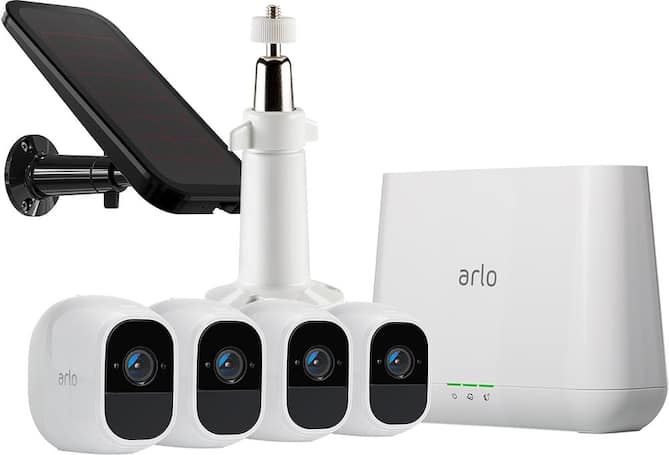Top 8 Things to Know About Solar-Powered Security Cameras

Best Selling Products carousel(5 Items)
How to shop for and benefit from solar-powered security cams
When setting up security cameras, you must connect them to your home's wiring systems to keep the devices powered. By choosing a solar-powered security camera, you eliminate this requirement. This makes the device a lot easier to install. When offered this option, you may ask questions like, what is a solar-powered security camera and how is it better than a regular security camera?
Solar-powered security cameras are standalone devices that do not require hard-wiring to set up. They draw power from solar panels (bundled or sold separately) and offer users better flexibility than wired security cameras. These security devices are an excellent fit for homes, offices and remote, off-grid locations like farms, cabins and construction sites. Before you search for the best solar-powered security camera for your building, you should know how security cameras work, their unique benefits and which factors to consider when shopping for them.
1. How do solar-powered security cameras work?
2. Are solar-powered security cameras better than regular ones?
If you're considering alternatives to regular security cameras, you may wonder are solar-powered security cameras any good? The answer is yes. Unlike wired security cameras, solar security cameras do not require running wires to connect them to power sources. They connect to home security systems via a Wi-Fi connection rather than data cables. Therefore, they're truly wireless security solutions and easier to install. With wired cameras, you need to put them on walls where power cables run or close to wall outlets. In contrast, you can install additional solar-powered security cameras anywhere, even if there isn’t an outlet nearby.
Solar-powered security cameras are also more convenient to use than regular wireless security cameras without solar panels. The latter require battery replacement or recharge every few months so you must take them down and then put them back up, which may feel like a hassle. Furthermore, while solar-powered security cameras can record continuously, regular wireless security cameras stay mostly in power-saving mode to conserve battery power and only wake up when they detect motion. This switch introduces delays that can make these cameras miss important moments.
3. Key features to look for in a solar-powered security camera
When searching for the best solar-powered security camera for your home or office, consider the following key features: camera resolution, field of view, solar panel wattage, night vision, motion activation, remote monitoring and smartphone alerts. Camera resolution determines the sharpness of the security footage captured by the security camera. Look for a model with a high-definition (HD) camera or sharper. Field of view describes the camera's coverage. A wider field of view is always better for a security camera. Night vision and motion activation indicate whether the camera can see at night and start recording when it detects motion within its coverage area. The wattage of the solar panel paired with a security camera indicates the amount of electric power it can generate from sunlight. A panel with a higher wattage charges the included battery faster and delivers more power to the security camera. Smartphone alerts and remote monitoring are features that help you monitor your home or office when you're not there.
Other optional features to consider when shopping for the best solar-powered security cameras available include two-way audio, geo fencing, integrated intruder siren and a built-in floodlight. These are security features that help with home monitoring at night and when you're away.
4. Solar-powered security cameras continue to work on cloudy days
5. Solar-powered security cameras are weatherproof
6. Solar-powered security camera smart home integration
You may also wonder whether solar-powered security cameras are any good for smart home systems. While some models are also smart home devices, check compatibility with your smart home platform, such as Apple HomeKit, Amazon Alexa or Google Home.
Cameras that integrate with smart home systems let users view security footage from their smart displays and smart TVs. Some models support the use of voice commands so you can even talk to smart locks to lock and unlock your doors when you’re away.
7. The importance of battery capacity when choosing a solar camera
8. Finding the best placement for a solar-powered security camera
The best solar-powered security camera placement is where the device receives the most sunlight and provides the best coverage. For a location with limited sun exposure, install the camera on a south-facing wall to receive at least 6 hours of sunlight every day. You should also install the camera high on the wall so intruders cannot easily reach to remove it. A smaller security camera is also more likely to go unnoticed by intruders.
Now that you know how solar-powered security cameras work, what are they and their reliability even on cloudy days, you can make a more informed decision about what model is the best solar-powered security camera for your home or office.